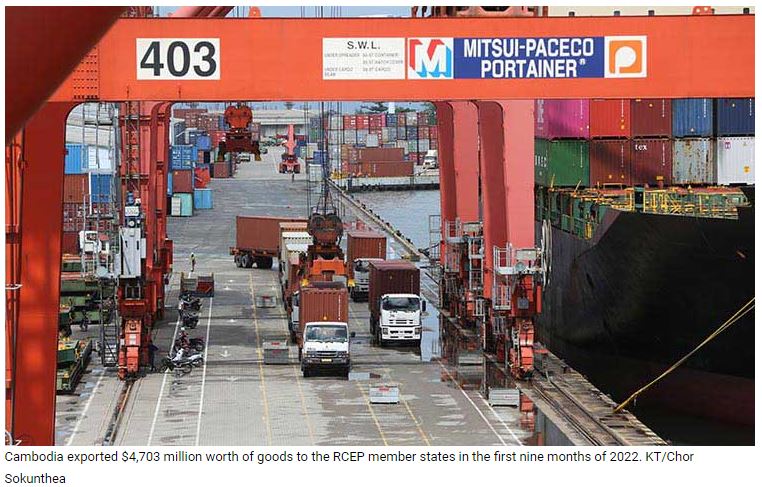CCFTA, RCEP boost Cambodia’s trade with China
The Cambodia-China Free Trade Agreement (CCFTA) and the Regional Comprehensive Economic Partnership (RCEP) have provided more momentum to bilateral trade between Cambodia and China, attracting new investment over the past year.
The two trade pacts entered into force on January 1, 2022.
More investment flowed into the region, including Cambodia, as businesses want to benefit from the bilateral FTA and mega trade pact’s tariff preferences, said Lim Heng, vice-president of the Cambodian Chamber of Commerce.
“Over the past year, the CCFTA and RCEP have provided a great impetus in terms of trade activities between Cambodia and China and with RCEP’s signatories,” Heng told Khmer Times yesterday.
“Under the CCFTA, Cambodia exports products directly, particularly agricultural products to China. Similarly, China is the sourcing market of raw materials for manufacturing in Cambodia for processing and producing final products for exports to the US, EU, and RCEP countries,” he said.
The bilateral trade volume hit $14.5 billion from January to November 2022, a year-on-year increase of 19.1 percent, the Economic and Commercial Office of the Chinese Embassy to Cambodia said in a release.
Data from the Ministry of Commerce (MOC) showed that Cambodia exported $4,703 million worth of goods to the RCEP member countries in the first nine months of last year, an increase of six percent when compared with the same period in the previous year, accounting for 27.2 percent of the Kingdom’s total export of $17,258 million during the period.
The Kingdom imported $19,363 million worth of merchandise from RCEP countries, a year-on-year increase of 12 percent.
The RCEP has contributed to the country’s export growth in the nine months of this year, Penn Sovicheat, under-secretary of state at the Ministry of Commerce, said.
“Since entering into force earlier this year, Cambodia’s export to the RCEP member states has significantly increased,” Sovicheat told Khmer Times.
Cambodia is one of the supply chains in the world, exporting garments, footwear, electronic and electrical components, and agriculture, which is the main factor that boosted the exports to the RCEP countries, Sovicheat said.
The regional trade pact comprises 15 Asia-Pacific countries including 10 member states of the Association of Southeast Asian Nations (ASEAN) — Brunei, Cambodia, Indonesia, Laos, Malaysia, Myanmar, the Philippines, Singapore, Thailand and Vietnam — and their five trading partners, namely China, Japan, South Korea, Australia and New Zealand.
Being the world’s largest trade bloc, the RCEP trade deal has a combined Gross Domestic Product (GDP) of $26.2 trillion, representing around 30 percent of global GDP, 28 percent of global trade, and 32.5 percent of global investment.
According to the RCEP, more than 90 percent of all merchandise traded in the region will eventually be subject to zero tariffs, an impetus for business celebrated by a growing number of companies.
Prime Minister Hun Sen said that the bilateral free trade agreements and the RCEP opened the market wider to Cambodian products, particularly agricultural items.
“Signing a free trade agreement with China is a huge opportunity for Cambodia’s agricultural market, and China is a huge market for Cambodia’s agricultural products,” he said last week.
CCC’s Heng said that the FTAs and RCEP would help the Kingdom gain market access to wider markets in the future, once the status of the EBA trade scheme and other trade preferences are removed from Cambodia.
Source: https://www.khmertimeskh.com/501212563/ccfta-rcep-boost-cambodias-trade-with-china/


 English
English




